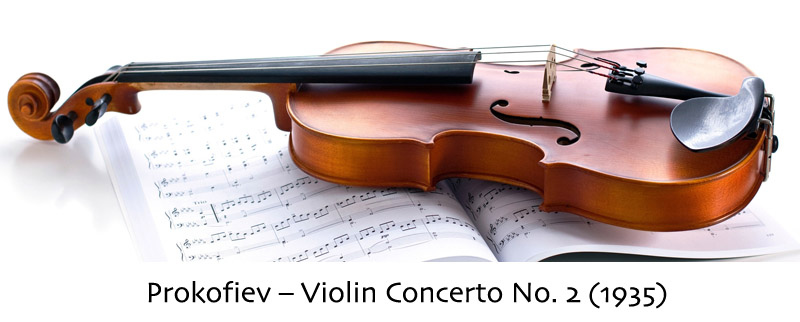
Background
Robinson, Harlow. Sergei Prokofiev: A Biography. New York: Viking Penguin, Inc., 1987. pp. 305-306.The Second Violin Concerto was Prokofiev’s last non-Soviet commission. It had been requested earlier in the year in France by a group of admirers of the French violinist Robert Soetens, on the condition that Soetens have sole right to perform the concerto for one year. In composing it, Prokofiev used some themes he had already been collecting with the violin piece in mind. “Reflecting my nomadic concertizing existence, the concerto was written in the most diverse countries: The main subject of the first movement was written in Paris, the first theme of the second movement–in Voronezh, the instrumentation was completed in Baku, and the premiere took place in December in 1935 in Madrid.”

Just as Prokofiev had hoped, the Second Violin Concerto is “completely different” from the equally brilliant First Violin Concerto written nearly twenty years earlier. Although both pieces have three movements, the first two the Second Concerto–each about ten minutes in length–are relatively slow. The First Concerto has faster tempos (including a Precipitous Vivacissimo) than the Second, and puts greater emphasis on velocity and the flashy technical dexterity in the solo part. But what is most different about the Second Concerto is its predominantly cantilena character: its melodies are some of the most beautiful, flowing and lyrical that Prokofiev ever wrote. Nor does he cut them short, impatient with emotional display, as he did in many of his earlier compositions–including, to some extent, the First Violin Concerto.
The Second Concerto never descends to the sentimental “Glazunovism” which Prokofiev always detested, however. Its characteristically “Prokofievian” rhythmic drive and strategically placed dissonances provide a bracing contrast to the prevailing lyrical mood. Particularly witty and original is the use of percussion–including castanets, triangle, bass drum and snare drum–in the concluding movement. In combination with the staccato double stops in the solo part, it creates a slightly ironic “Spanish” atmosphere. Perhaps to break the lyrical spell of the opening movements, the concerto comes to an abrupt end with an ascending run in eighth notes–tumultuoso–in the solo part. The First Concerto does precisely the opposite, ending with an ethereal return to it fragile opening theme to counterbalance the predominating speed and aggressiveness of what has come before.
The Second Concerto achieved an immediate and lasting success both with critics and the public. Even Prokofiev was pleased, and told Miaskovsky, after the premiere in Madrid on December 1, “It seems as though the concerto is a success. . . . somehow the music immediately reached the audience. But now I still want to look it over again and add a few details here and there. “ It would be published in full score by Gutheil in Europe in 1937, and in a piano-violin version in the U.S.S.R. in 1938, and has been many times recorded by leading violin virtuosi.
Ewen, David. Encyclopedia of Concert Music. New York: Hill & Wang, 1959, p. 100.
I. Allegro moderato
This emphasis on broad lyricism is immediately apparent in the expressive song for solo violin unaccompanied with which the first movement opens. Later on, the solo violin also presents the second, equally lyrical subject. In the development the main theme appears in the lower strings of the orchestra after which the solo violin takes up the second theme. The opening theme is amplified in the coda.

II. Andante assai
In the slow movement, the solo violin is heard in an extended song against a pizzicato background. While other episodic material is subsequently presented, this melody is the heart of the movement. The coda, in which the solo violin takes over the opening accompaniment in an pizzicato passage, ends with a brief duet for clarinet and solo double bass.

III. Allegro ben marcato
The finale is a mixture of rondo and sonata components, in which strong rhythmic passages alternate with satiric comments. The opening subject is forcefully stated by the solo violin.

A larger important thought is introduced by the solo violin on the G string. A dramatic coda, in which the violin is accompanied only by the bass drum and the lower strings, comes as a conclusion.
Wikipedia: Violin_Concerto_No._2_(Prokofiev)
The concerto is more conventional than the composer's early bold compositions. It starts off with a simple violin melody related to traditional Russian folk music. The graceful violin melody flows throughout the entire second movement, and ends with the initial violin theme reappears in solo cello, accompanied by solo violin. The third movement rondo's theme has a taste of Spain, with the clacking of castanets each time the theme appears. Apart from the solo violin, the concerto is scored for moderate-sized orchestra including two flutes, two oboes, two clarinets, two bassoons, two horns, two trumpets, snare drum, bass drum, castanets, cymbals, triangle, and strings.